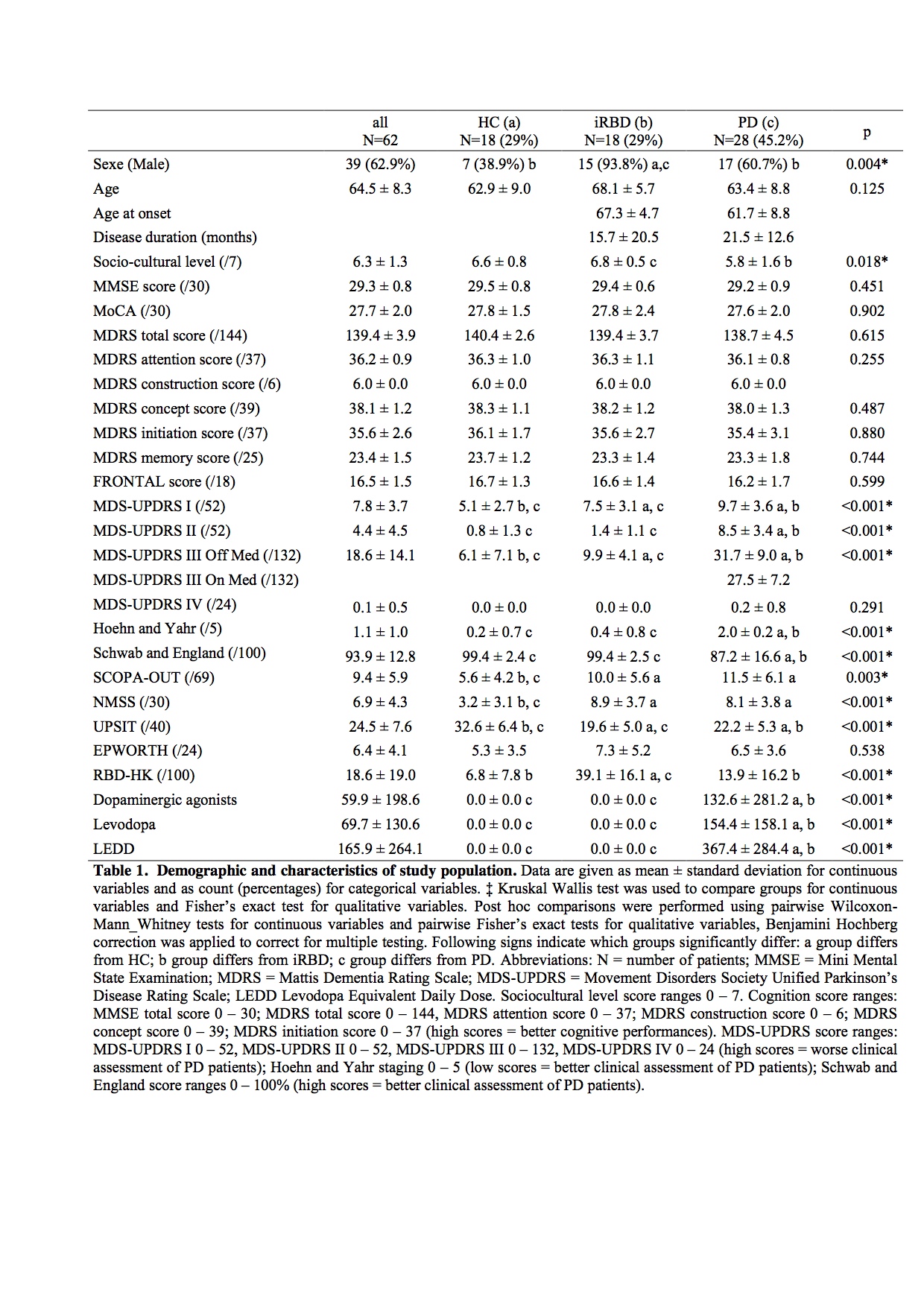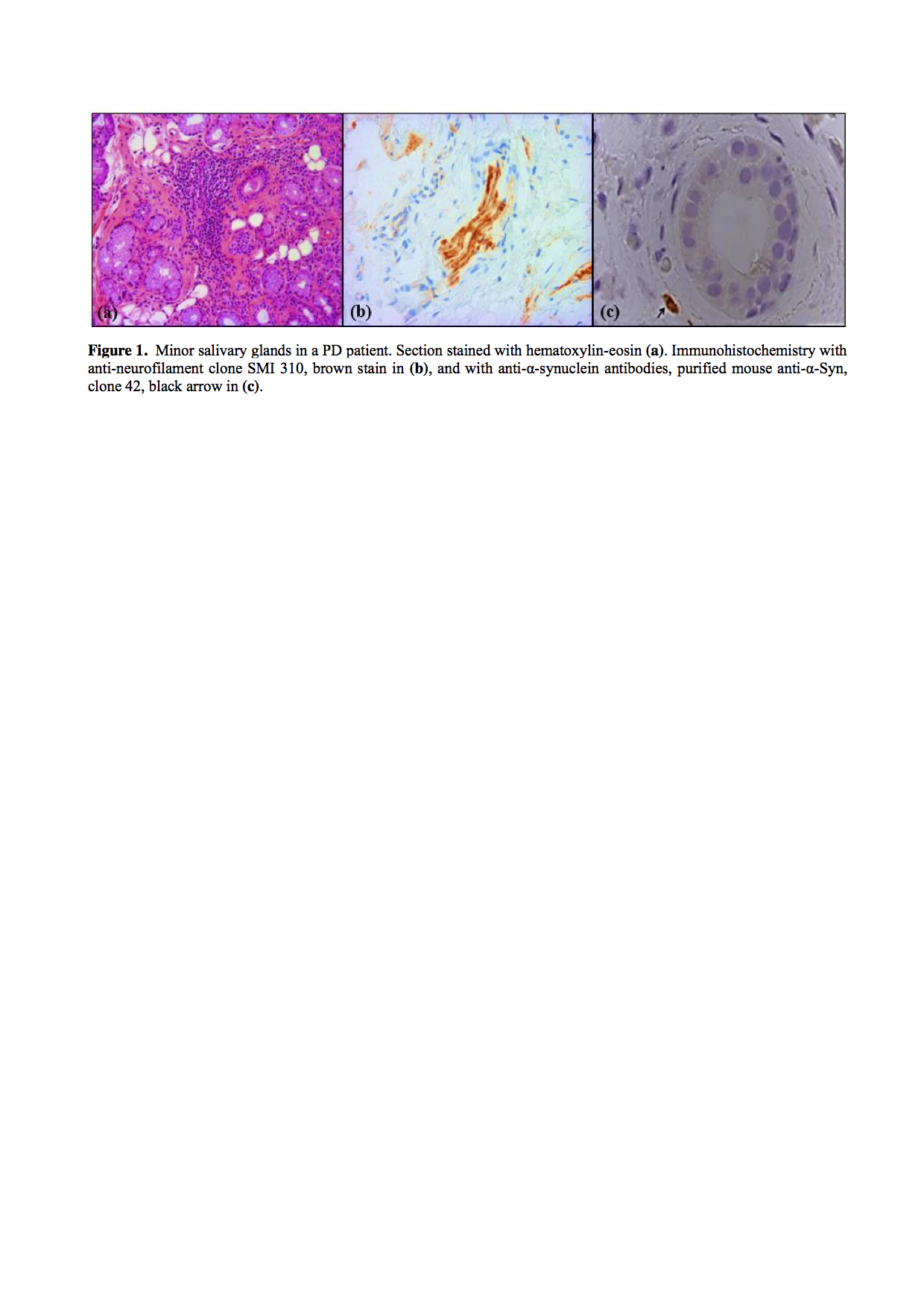Objective: To investigate the presence of α-Syn immunostaining in minor salivary gland biopsies (MSGB) from patients with idiopathic Parkinson’s disease (PD), idiopathic Rapid Eye Movement Behavior Disorders (iRBD) and healthy controls (HC). To better understand the pathophysiology of PD and whether or not there is an early peripheral involvement. To test the hypothesis that MSGB is an easy to do and useful biomarker predictive of progression from iRBD to PD.
Background: In PD, pathologic α-Syn deposits in the peripheral autonomic nervous system has been shown, although less studied than in the brain.
Method: In all participants, recruited prospectively at the Pitié-Salpêtrière Hospital, MSGB were performed. The tissue was fixed in paraformaldehyde solution, embedded in paraffin, stained with hematoxylin-eosin and then immunostained with two α-Syn antibodies (anti-aggregated α-Syn clone 5G4 and purified mouse anti-α-Syn, clone 42) and an anti-neurofilament H and M (clone SMI 310). Three 5 µm thick sections were studied per participant. All participants underwent a thorough clinical history, neurological examination including a complete Movement Disorders Society Unified Parkinson Disease Rating Scale (MDS-UPDRS), non-motor symptoms scales (SCOPA-AUT, NMSS), neuropsychological evaluation, video-polysomnography and brain imaging (MRI and 123I-DaTscan SPECT). Generalized linear regressions (GLMs) were performed to compare marker values between clinical status adjusted for gender and age.
Results: We included 62 participants (18 HC,18 iRBD and 28 PD). The male/female ratio (percentage in men PD= 61%, iRBD= 94%, HC= 39%, p = 0.003), age (PD= 63.4 ± 8.8, iRBD= 68.1 ± 5.7, HC= 62.9 ± 9.0, p= 0.125), and level of education (mean ± standard deviation years PD= 5.8 ± 1.6, iRBD= 6.8 ± 0.5, HC= 6.6 ± 0.8, p= 0.018) were significantly different between the three groups (Table 1). Deposits of α-Syn were found in 15 PD (53.6%), in 7 iRBD (38.9%) and in 7 HC (38.9%) using the anti-aggregated α-Syn clone 5G4 antibody and in 4 PD (14.3%), in 3 iRBD (18.8%) and in none of HC using the purified mouse anti-α-Syn, clone 42 antibody (Figure 1). No statistical difference was found between groups on deposits of α-Syn. All subjects underwent MSGB without complications.
Conclusion: Our results suggest that MSGB does not have high diagnostic accuracy and can not be used as a predictive biomarker of conversion from iRBD to PD.
To cite this abstract in AMA style:
G. Mangone, M. Houot, S. Boluda Casas, A. Chalancon, A. Prigent, D. Seilhean, JC. Corvol, M. Vidailhet, C. Duyckaerts, B. Degos. Double labeling alpha-synuclein in labial minor salivary glands in Parkinson’s disease and idiopathic RBD patients [abstract]. Mov Disord. 2021; 36 (suppl 1). https://www.mdsabstracts.org/abstract/double-labeling-alpha-synuclein-in-labial-minor-salivary-glands-in-parkinsons-disease-and-idiopathic-rbd-patients/. Accessed December 7, 2025.« Back to MDS Virtual Congress 2021
MDS Abstracts - https://www.mdsabstracts.org/abstract/double-labeling-alpha-synuclein-in-labial-minor-salivary-glands-in-parkinsons-disease-and-idiopathic-rbd-patients/


